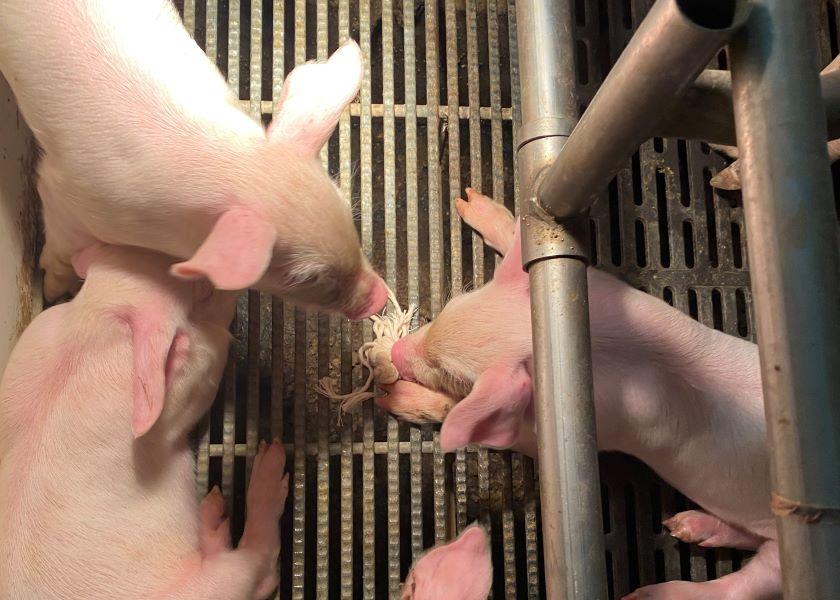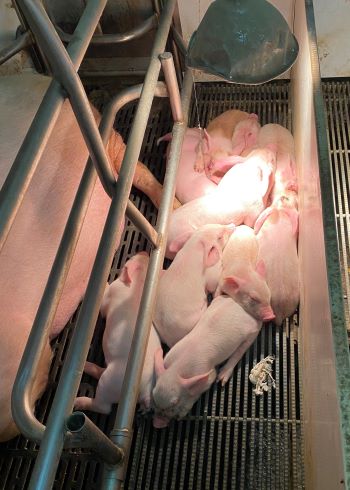Why Not Rope Knot? New Way to Test Wean Pigs for PRRS Could Save Time, Money

After spending a summer working with pigs and seeing not only the devastating effect of porcine reproductive and respiratory syndrome (PRRS) on a sow farm, but also the labor shortage crisis facing the swine industry, Carly Bates wanted to find a way to help.
Bates, a student in Iowa State University’s College of Veterinary Medicine, says the innovative project she pursued helps combat both of these current challenges. She presented her findings during “Clinical Cases and Problem-Solving Skills by DVM Students” at the 2022 Allen D. Leman Swine Conference.
What’s the Problem?
Testing for PRRS in due-to-wean pigs can be challenging and time-consuming. Bates wanted to find a more efficient and effective method for PRRS virus testing.
“There are several options that producers can use for detection methods currently, but unfortunately most of the methods currently used are very time consuming, have costly diagnostic submission fees and cause stress events for pigs and/or sows,” Bates says.
The most common standard for due-to-wean surveillance is serum testing 30 to 60 pigs in a population. In addition to the time it takes, it also requires training and is not a population sample, she adds.
Bates decided to compare rope knot oral fluid sampling to these established methods.

The rope knot is a 15” non-bleached rope was tied three times to create a rope that was 6” in length with a ¾” thick knot in the middle.
3 Ways to Obtain Samples
Three sampling methods were conducted on 15 due-to-wean litters. In the rope knot sample, a 15” non-bleached rope was tied three times to create a rope that was 6” in length with a ¾” thick knot in the middle. The rope knot was placed under the heat lamp and checked every 30 minutes until the majority of the rope knots had noticeable saturation (1.5 hours total). Rope knots were then collected and placed into individual bags. One mL of fluid was poured from each bag. If this wasn’t possible, Bates says 10 mL of phosphate buffered saline was added to the bag and agitated before pouring. Remaining contents were later combined for a pooled sample that was sent off for testing with the 15 individual samples.
The second sample collected used udder wipes. Gauze pads were soaked in 8 mL of phosphate buffered saline. The gauze was wiped along the underline of each sow for 15 seconds and collected in individual bags. The pads were thoroughly agitated, and 1 mL of fluid was poured out. Remaining contents were then combined for a pooled sample, too.
The third sample was collected by serum sampling five pigs per litter. The serum was pooled by litter for testing. Blood collection was completed last, Bates says, to avoid cross-contamination and prevent stress in piglets prior to the rope knot sampling.

Rope knot sampling was easily executed, leads to minimal crate-to-crate contamination, is more welfare-friendly and a promising testing method for due-to-wean pigs, Carly Bates says.
Rope Knots Work, Bates Says
Bates says the results showed rope knots are a successful and efficient PRRS virus detection method.
“This revealed oral fluids collected by a rope knot in due-to-wean pigs had the same testing results (positive/negative) as serum samples. Oral rope knot fluids took significantly less collection time compared to serum samples and will ultimately result in a true population sample with lower submission costs,” Bates explains.
Some rope knots were reached by the sow, therefore capturing oral fluids, she says. The effect of this needs further exploration.
“Ultimately, rope knot sampling was easily executed, leads to minimal crate-to-crate contamination, is more welfare-friendly and a promising testing method for due-to-wean pigs,” Bates says. “The next step is to repeat this trial in a low-prevalence herd to determine if the method is sensitive enough to pick up low numbers of positive samples in a population.”
Bates believes these findings are valuable to pork producers as a possible sampling method to explore that has great potential in any farm setting.
“This is also a great option to consider in the midst of a PRRS virus outbreak,” she adds. “The rope knot can help eliminate cross-contamination between crates which will serve to get the farm back to full potential.”
More from Farm Journal's PORK:
Consistency is Critical When Training New Boar Stud Employees
Fill Your Nursery Site in Fewer Groups to Maximize Pig Exit Weight
Pork Industry Steps Up to Address Wean-to-Harvest Biosecurity
Biosecurity: Are We Adding Hazards Faster Than Control Measures?
Say That Again: Favorite Moments from Day One of the Leman Conference
Boehringer Ingelheim Awards 2022 GRANTS Recipients
Morrison Swine Innovator Prize Winner Takes a Deeper Look at Lawsonia







